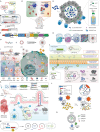Physiochemically and Genetically Engineered Bacteria: Instructive Design Principles and Diverse Applications
- PMID: 38864372
- PMCID: PMC11321697
- DOI: 10.1002/advs.202403156
Physiochemically and Genetically Engineered Bacteria: Instructive Design Principles and Diverse Applications
Abstract
With the comprehensive understanding of microorganisms and the rapid advances of physiochemical engineering and bioengineering technologies, scientists are advancing rationally-engineered bacteria as emerging drugs for treating various diseases in clinical disease management. Engineered bacteria specifically refer to advanced physiochemical or genetic technologies in combination with cutting edge nanotechnology or physical technologies, which have been validated to play significant roles in lysing tumors, regulating immunity, influencing the metabolic pathways, etc. However, there has no specific reviews that concurrently cover physiochemically- and genetically-engineered bacteria and their derivatives yet, let alone their distinctive design principles and various functions and applications. Herein, the applications of physiochemically and genetically-engineered bacteria, and classify and discuss significant breakthroughs with an emphasis on their specific design principles and engineering methods objective to different specific uses and diseases beyond cancer is described. The combined strategies for developing in vivo biotherapeutic agents based on these physiochemically- and genetically-engineered bacteria or bacterial derivatives, and elucidated how they repress cancer and other diseases is also underlined. Additionally, the challenges faced by clinical translation and the future development directions are discussed. This review is expected to provide an overall impression on physiochemically- and genetically-engineered bacteria and enlighten more researchers.
Keywords: bacterial derivatives; design principles; diverse applications; genetically‐engineered bacteria; physiochemically‐engineered bacteria.
© 2024 The Author(s). Advanced Science published by Wiley‐VCH GmbH.
Conflict of interest statement
The authors declare no conflict of interest.
Figures










Similar articles
-
Engineered Microorganisms for Advancing Tumor Therapy.Adv Mater. 2024 Jun;36(24):e2313389. doi: 10.1002/adma.202313389. Epub 2024 Mar 22. Adv Mater. 2024. PMID: 38485221 Review.
-
Engineering advanced bacterial therapy for tumor and inflammatory diseases.Int J Pharm. 2025 May 15;676:125585. doi: 10.1016/j.ijpharm.2025.125585. Epub 2025 Apr 10. Int J Pharm. 2025. PMID: 40216039 Review.
-
Progress of engineered bacteria for tumour therapy.Int Immunopharmacol. 2024 May 10;132:111935. doi: 10.1016/j.intimp.2024.111935. Epub 2024 Apr 9. Int Immunopharmacol. 2024. PMID: 38599096 Review.
-
Bacterially mediated drug delivery and therapeutics: Strategies and advancements.Adv Drug Deliv Rev. 2022 Aug;187:114363. doi: 10.1016/j.addr.2022.114363. Epub 2022 May 29. Adv Drug Deliv Rev. 2022. PMID: 35649449 Review.
-
Engineering Diagnostic and Therapeutic Gut Bacteria.Microbiol Spectr. 2017 Oct;5(5):10.1128/microbiolspec.bad-0020-2017. doi: 10.1128/microbiolspec.BAD-0020-2017. Microbiol Spectr. 2017. PMID: 29052539 Free PMC article. Review.
Cited by
-
Stealth missiles with precision guidance: A novel multifunctional nano-drug delivery system based on biomimetic cell membrane coating technology.Mater Today Bio. 2025 May 30;33:101922. doi: 10.1016/j.mtbio.2025.101922. eCollection 2025 Aug. Mater Today Bio. 2025. PMID: 40528836 Free PMC article. Review.
-
Targeting neutrophil extracellular traps in cancer progression and metastasis.Theranostics. 2025 Apr 22;15(12):5846-5869. doi: 10.7150/thno.111096. eCollection 2025. Theranostics. 2025. PMID: 40365275 Free PMC article. Review.
References
-
- Liu Y., Zhang M., Wang X., Yang F., Cao Z., Wang L., Liu J., Adv. Mater. 2023, 35, 2210949. - PubMed
-
- Xiong Y., Lin Z., Bu P., Yu T., Endo Y., Zhou W., Sun Y., Cao F., Dai G., Hu Y., Lu L., Chen L., Cheng P., Zha K., Shahbazi M.‐A., Feng Q., Mi B., Liu G., Adv. Mater. 2023, 35, 2212300. - PubMed
-
- Zhang Y., Pan T., Li C.‐X., Zheng D., Sun Y., Zhang X.‐Z., Nano Lett. 2022, 22, 5575. - PubMed
-
- Xu T., Hu J. W., Fang C., Luo T., Liu J. J., Zhang K., ACS Mater. Lett. 2023, 5, 1892.
Publication types
MeSH terms
Grants and funding
LinkOut - more resources
Full Text Sources
